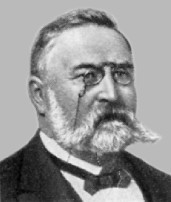Johannes Schmidt (linguist) facts for kids
Quick facts for kids
Johannes Schmidt
|
|
|---|---|
 |
|
| Born |
Johannes Friedrich Heinrich Schmidt
July 29, 1843 Prenzlau, Province of Brandenburg
|
| Died | July 4, 1901 Berlin, Province of Brandenburg
|
| Known for | Wave model |
Johannes Friedrich Heinrich Schmidt (born July 29, 1843 – died July 4, 1901) was a smart German linguist. A linguist is someone who studies languages. He is famous for creating the Wellentheorie, also known as the wave theory. This idea helps us understand how languages change and spread over time.
Contents
Schmidt's Life Story
Early Life and Education
Johannes Schmidt was born in a town called Prenzlau, which was part of the Province of Brandenburg in Germany. He went to two important universities: Bonn and Jena.
At these universities, he studied philology. Philology is a fancy word for the study of language in old texts, especially how languages have changed over history. His main teacher was August Schleicher. Schmidt focused on Indo-European languages, which are a big family of languages spoken across Europe and parts of Asia. He was especially interested in Slavic languages, like Russian or Polish.
Johannes Schmidt earned his doctorate degree in 1865. This is a very high academic degree. After that, from 1866, he worked as a teacher. He taught at a gymnasium in Berlin. A gymnasium is a type of high school in Germany that prepares students for university.
The Wave Theory of Language
In 1868, the University of Bonn asked Schmidt to become a professor. He taught German and Slavic languages there. While at Bonn, he wrote an important book in 1872. Its title in English means The Relationships of the Indo-Germanic Languages.
In this book, he shared his famous Wellentheorie, or 'wave theory'. Imagine throwing a stone into a pond. You see ripples, or waves, spreading out from the center. Schmidt believed that new features in a language spread in a similar way. They start in one area and then spread outwards. As they spread, they get weaker, just like ripples in water.
This theory suggested that different languages could become more alike if they were close to each other. It was a new idea that challenged some older ways of thinking about how languages change. For example, it was different from the ideas of the Neogrammarians, who focused more on strict sound laws.
Later Career and Death
From 1873 to 1876, Schmidt worked as a professor at the University of Graz in Austria. Then, in 1876, he moved back to Berlin. There, he became a professor at the Humboldt University.
Johannes Schmidt continued his important work in Berlin. He passed away in Berlin when he was fifty-seven years old. His wave theory remains an important idea in the study of how languages develop and spread.

